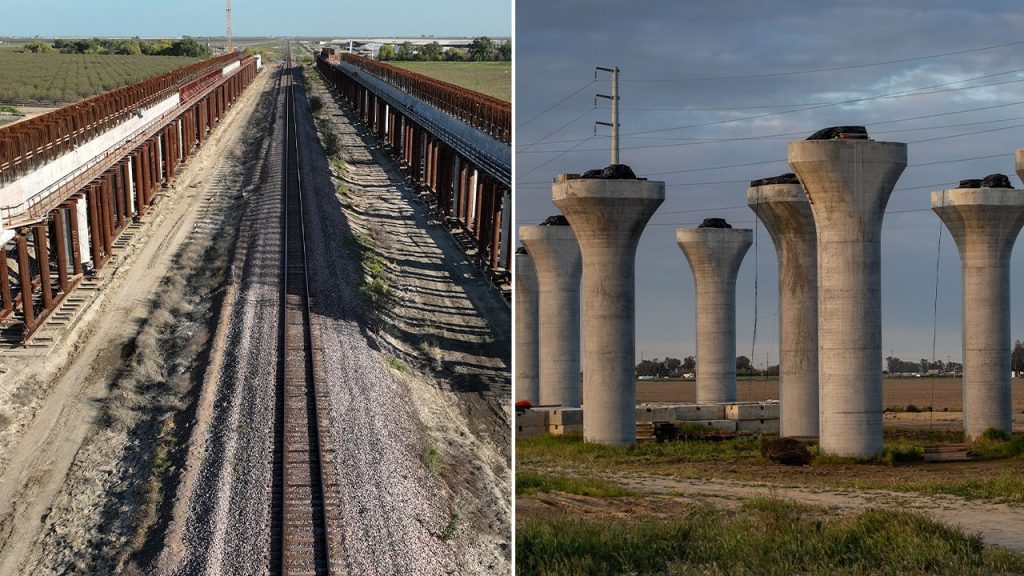California’s ambitious high-speed rail project, envisioned as a transformative transportation solution, finds itself mired in controversy, with prominent Democrats pushing for crucial federal funding while facing staunch opposition from Republicans and some prominent figures. A group of California Democrats, including Senator-elect Adam Schiff and Senator Alex Padilla, have formally requested $536 million in federal grants from the Department of Transportation. This funding, allocated under the Bipartisan Infrastructure Law, would be a significant boost to the beleaguered project, specifically targeting the construction of critical tunnels through the Tehachapi and Diablo mountain ranges. These tunnels are considered essential for connecting the high-speed rail network with existing intercity passenger rail systems, creating a more comprehensive and integrated transportation network for the state.
The Democrats argue that the high-speed rail project is not merely a transportation endeavor; it’s a vital investment in California’s future. They emphasize its potential to address climate change by reducing greenhouse gas emissions, improve public health by promoting alternative modes of transportation, enhance connectivity between different regions of the state, and stimulate economic growth by creating jobs and supporting small businesses. Furthermore, they highlight the project’s focus on equitable access, particularly for disadvantaged communities, including those in agricultural regions, who often lack reliable and efficient transportation options. The requested funding, they contend, will be instrumental in moving the project beyond its current focus on the Central Valley and extending its reach to other parts of the state.
However, the project has been plagued by delays, cost overruns, and political opposition. Republicans, including California Representative Kevin Kiley and State Senator Brian Jones, have vehemently criticized the project, labeling it a “boondoggle” and a prime example of government waste. They point to the project’s ballooning budget, now estimated to be nearly $100 billion over its initial projections, and its significantly delayed timeline, which is decades behind schedule. They argue that the project is fiscally irresponsible and unlikely to deliver on its promises.
Adding to the chorus of criticism are influential figures like Elon Musk and Vivek Ramaswamy, both of whom have voiced their disapproval of the project. Musk, in a 2013 conference, proposed an alternative concept, the “Hyperloop,” which he envisioned as a faster and more cost-effective solution for high-speed travel between Los Angeles and San Francisco. Ramaswamy has echoed these sentiments, calling the high-speed rail a “wasteful vanity project” with little chance of completion in the foreseeable future. He has urged an end to further funding, citing former President Trump’s 2019 decision to rescind $1 billion in federal funding for the project, a decision later reversed by the Biden administration.
The debate over the high-speed rail project reflects a broader ideological divide on the role of government in infrastructure development. Democrats view the project as a necessary public investment in a sustainable and equitable future, while Republicans see it as an example of government overreach and wasteful spending. This clash of perspectives underscores the challenges in achieving consensus on large-scale infrastructure projects, particularly in a politically polarized environment.
The fate of the California high-speed rail project now hangs in the balance, awaiting the Department of Transportation’s decision on the grant application. The $536 million in federal funds, if approved, would be supplemented by $134 million from California’s cap-and-trade program, providing a much-needed infusion of capital. However, even with this funding, the project faces significant hurdles, including ongoing political opposition, escalating costs, and technical challenges. The project’s ultimate success or failure will have far-reaching implications for California’s transportation future and serve as a case study for the challenges and complexities of large-scale infrastructure projects in the 21st century. The decision on the grant application will not only determine the immediate future of the project but also set the stage for a continued debate on the role of government in shaping the future of transportation.

